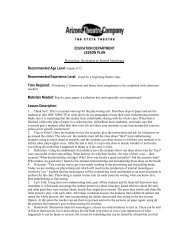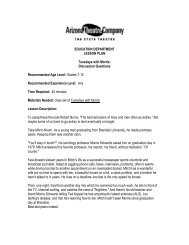Play Guide [1.2MB PDF] - Arizona Theatre Company
Play Guide [1.2MB PDF] - Arizona Theatre Company
Play Guide [1.2MB PDF] - Arizona Theatre Company
You also want an ePaper? Increase the reach of your titles
YUMPU automatically turns print PDFs into web optimized ePapers that Google loves.
DEPRESSION<br />
companies and stock prices quadrupled between 1921 and 1929. After the Federal Reserve<br />
implemented higher interest rates to lower rising prices, banks and investors lost certainty<br />
and began selling their stocks. Suddenly, between September and October 1929, stock<br />
prices fell 33%. The ultimate day of panic selling occurred on October 24, 1929, which is<br />
known as “Black Thursday.” The additional lack of consumers and investors forced prices<br />
down further and as a preventative measure against bankruptcy, people sold their holdings.<br />
After the Stock Market Crash, unemployment increased, consumer goods prices declined,<br />
and industrial manufacturing declined 47% in the United States. The rise in unemployment<br />
and uncertainty about the future prevented consumers from spending money and investing<br />
in products. The Crash marked the beginning of the ten year battle against the effects of the<br />
Great Depression.<br />
"I pledge you, I pledge myself, to a new deal for<br />
the American people." – Franklin D. Roosevelt<br />
The New Deal<br />
Under the strain of the Great Depression, President<br />
Franklin D. Roosevelt commissioned The New Deal<br />
program in 1933, which was designed to "give a hand up,<br />
not a hand out." This program promised to repair America<br />
and help with poverty, unemployment, and the collapsing<br />
American economy. The largest New Deal Agency was the<br />
Works Progress Administration, which was created by the<br />
Emergency Relief Appropriation Act of 1935. The Works<br />
Progress Administration (or WPA as it was commonly known)<br />
employed millions of Americans primarily in unskilled labor Men working for the WPA<br />
jobs. Workers constructed public buildings and roads, though<br />
other projects included art, theatre and literacy projects. Congress ended the WPA in 1943<br />
during World War II when unemployment concerns fell by the wayside. Prior to 1943, the<br />
WPA was the largest employer in the country.<br />
-written by Kelli Marino, dramaturgical intern and Jenny Bazzell, Literary Manager<br />
WOMEN IN THE 1930s IN ST. LOUIS<br />
Why would Amanda push so hard for Laura to get married? Though it might seem<br />
strange in a modern context, in 1930 getting married and raising a family was the most<br />
accepted thing a young woman could do with her life. Anything else was considered<br />
suspicious. Women won the right to vote in 1920 but that didn’t change the strong<br />
bias that a woman’s place was in the home and that a man should be the primary<br />
breadwinner—even though that prejudice was a little out of step with a changing<br />
reality. In St. Louis there were somewhere around 1200 soldiers that never came<br />
home from World War I. With their husbands lost to the war, the need to support their<br />
families alone forced women into the workforce in greater numbers. During the Great<br />
The Glass Menagerie<br />
<strong>Arizona</strong> <strong>Theatre</strong> <strong>Company</strong> <strong>Play</strong> <strong>Guide</strong> 12


![Play Guide [1.2MB PDF] - Arizona Theatre Company](https://img.yumpu.com/11952176/12/500x640/play-guide-12mb-pdf-arizona-theatre-company.jpg)
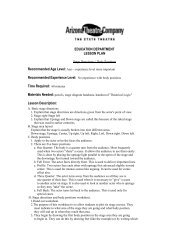



![Play Guide [356k PDF] - Arizona Theatre Company](https://img.yumpu.com/46218320/1/190x245/play-guide-356k-pdf-arizona-theatre-company.jpg?quality=85)

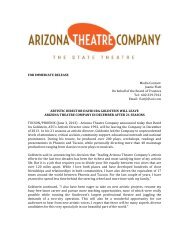


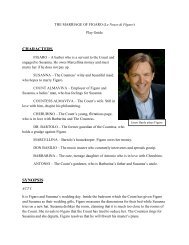
![[title of show] Arizona Theatre Company Play Guide 1](https://img.yumpu.com/24482689/1/190x245/title-of-show-arizona-theatre-company-play-guide-1.jpg?quality=85)
